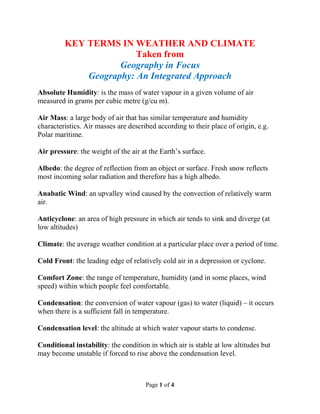
Key terms in weather and climate
- 1. KEY TERMS I WEATHER A D CLIMATE Taken from Geography in Focus Geography: An Integrated Approach Absolute Humidity: is the mass of water vapour in a given volume of air measured in grams per cubic metre (g/cu m). Air Mass: a large body of air that has similar temperature and humidity characteristics. Air masses are described according to their place of origin, e.g. Polar maritime. Air pressure: the weight of the air at the Earth’s surface. Albedo: the degree of reflection from an object or surface. Fresh snow reflects most incoming solar radiation and therefore has a high albedo. Anabatic Wind: an upvalley wind caused by the convection of relatively warm air. Anticyclone: an area of high pressure in which air tends to sink and diverge (at low altitudes) Climate: the average weather condition at a particular place over a period of time. Cold Front: the leading edge of relatively cold air in a depression or cyclone. Comfort Zone: the range of temperature, humidity (and in some places, wind speed) within which people feel comfortable. Condensation: the conversion of water vapour (gas) to water (liquid) – it occurs when there is a sufficient fall in temperature. Condensation level: the altitude at which water vapour starts to condense. Conditional instability: the condition in which air is stable at low altitudes but may become unstable if forced to rise above the condensation level. Page 1 of 4
- 2. Convectional precipitation: precipitation caused when relatively warm convection currents of air rise and cool – causing water vapour to condense. Coriolis Force: the effect caused by the Earth’s rotation on its axis of deflecting air flows to the right in the Northern Hemisphere and to the left in the Southern Hemisphere. Cyclone: (or depression or low) – an area of converging, rising air with low atmospheric pressure at the Earth’s surface. Depression: an area of low pressure in which air tends to converge (at low altitudes) and rise. Dew point: the temperature at which water vapour condenses. Dry Adiabatic Lapse Rate: (DALR) The rate at which unsaturated air cools when it rises (or warms when it subsides). E SO (El ino Southern Oscillation): the name given by scientists to the reversal of normal Pacific Ocean wind and pressure systems. Off the coast of Peru, an ENSO event is marked by an increase in sea surface temperatures. Environmental Lapse Rate: (ELR) the rate at which temperature falls with increased height. Flip-Flop: the switch from one climate state to another e.g. warm to cold, or cold to warm. Fog: water droplets that have condensed at ground level, reducing visibility to less than 1 km. Frost Hollow: a valley or depression where frost is more likely than on higher slopes. Greenhouse effect: the warming blanket effect of atmosphere gases such as water vapour and carbon dioxide. Greenhouse gas: an atmospheric gas, such as carbon dioxide or methane, which allows short wave solar radiation to reach the Earth’s surface but then absorbs and retains long wave radiation (heat energy) from the surface. Page 2 of 4
- 3. Inversion: a rise in temperature with increased altitude – the reverse of normal conditions. Isobar: a line on a weather chart joining points of equal air pressure. Jet Stream: a concentrated fast flowing air flow in the upper troposphere. Katabatic Wind: a downvalley wind caused by the sinking of relatively cold, dense air. Latent Heat: is the amount of heat energy needed to change the state of a substance without affecting its temperature. Meteorology: the study of atmospheric phenomena, it includes the study of both weather and climate (climatology). Microclimate: a distinct pattern of climatic condition that occurs in relatively small area. Monsoon: the seasonal reversal of winds and pressure systems in Central Asia and the Indian Ocean. Orographic or relief precipitation: precipitation caused when an air flow is forced to rise over high ground. Pressure gradient: the change in air pressure between two points. A steep gradient is shown on a weather chart by closely drawn isobars and indicates strong winds. Prevailing winds: the wind direction that is most frequent. Rain Shadow: an area of relatively low precipitation on the leeward or sheltered side of high ground. Relative Humidity: the ratio of the actual amount of water vapour held in air to the maximum amount of water vapour that could be held if the air is saturated (expressed as a percentage). Rossby wave: wave-like pattern of winds in the upper troposphere. Page 3 of 4
- 4. Saturated air: air that is holding the maximum possible quantity of water vapour (at a given temperature). Saturated Adiabatic Lapse Rate: (SALR) the rate at which saturated air cools when it rises (or warms when it subsides). Sea breeze: a wind that blows onshore during the day. Stable conditions: the air has no tendency to rise (because it is the same temperature or cooler than surrounding air). Sublimation: is when water vapour condenses directly into ice crystals without passing through the liquid state. Tornado: a powerful rotating wind system that can be very destructive. Tropical Cyclone: or hurricane or typhoon – a destructive weather system with spiralling winds at speeds over 120km/h, heavy rain and sometimes causing a storm surge. Tropopause: the upper boundary of the troposphere Troposphere: the lowest layer of the atmosphere within which most weather occurs. Unstable conditions: the air has a tendency to rise (because it is warmer than the surrounding air). Urban Heat Island: an urban area where the temperature is higher than the surrounding region. Warm Front: the leading edge of relatively warm air in a depression. Weather: the state of the atmosphere at any one time, for example temperature, precipitation, wind and cloud cover. Page 4 of 4